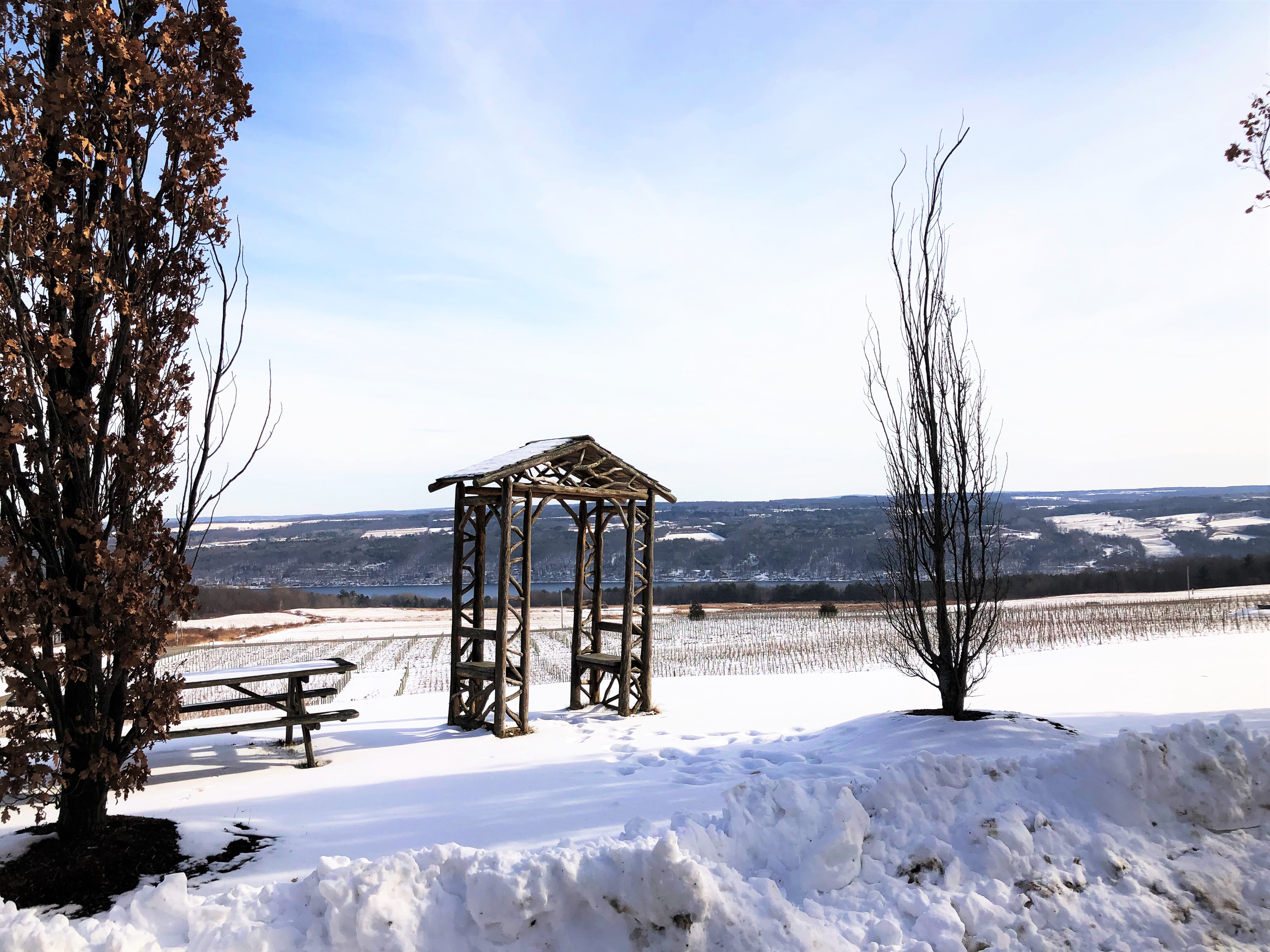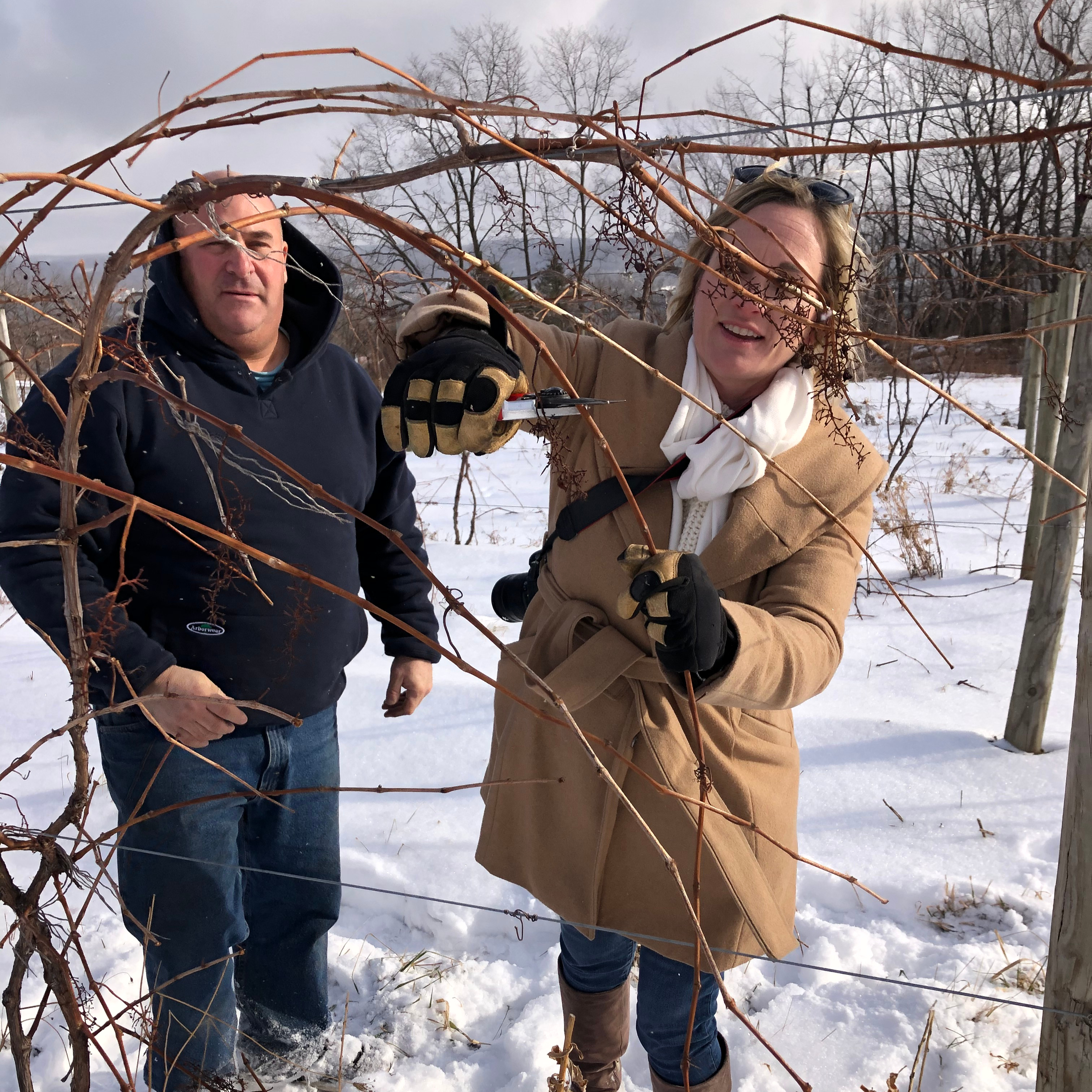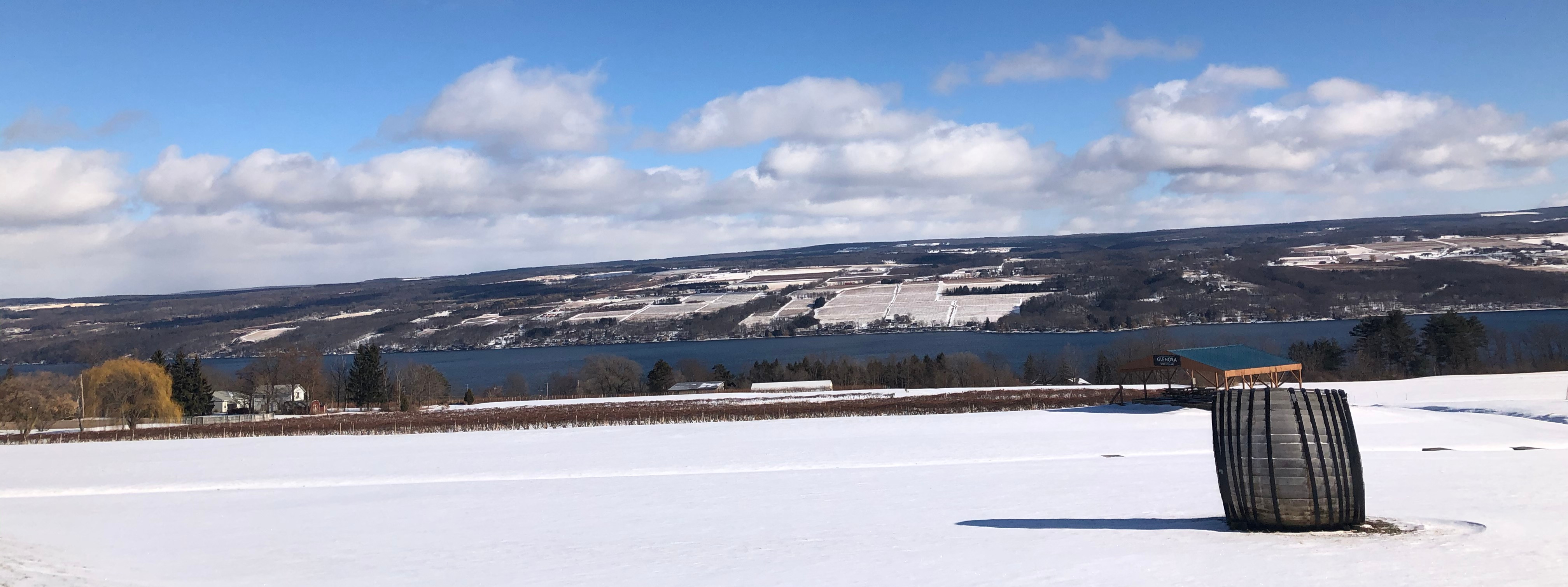
Mother Nature:
The Great Protector
Josh Wig of Lamoreaux Landing Wine Cellars on Seneca agrees adding, “Snow provides insulation and is welcome at any point in the winter. It’s the sub-zero air temperatures we have to watch for, but Seneca Lake’s temperature mitigation is usually enough to keep us from any severe damage.”
The Finger Lakes were carved out by glaciers during the Ice Age and these deep, fresh-water lakes, particularly Keuka, Seneca and Cayuga, provide moderating influences on the local climate.
While winter sets in around Thanksgiving and can run into April, the lakes provide protection from extreme winter temperatures – which are dangerous for the vines.
And all that snow? Well, it’s actually beneficial.
“We like the snow as it provides a “blanket” for the vines and root systems,” said Gene Pierce of Knapp Vineyards on Cayuga Lake. “The snow helps to protect the graft union (where the vine is grafted to the rootstock) as well as keeps the frost from extending too far into the soil.”
In fact, Seneca and Cayuga Lakes, rarely freeze over, owing to their large surface areas and wide-swept hills on either side of the lakes. As a result, the neighboring vineyards are often protected from those damaging sub-zero temperatures.
As for Keuka Lake, while the northern and southern ends often do freeze over (making for great ice fishing and ice-skating opportunities), the deepest parts of the lake remain unfrozen offering that continued protection.
“They say vines like a view,” - August Deimel of Keuka Spring Vineyards
Vineyard Management
In addition, to the natural protections of the Finger Lakes, vineyard managers, viticulturists and farmers have many options available to work alongside Mother Nature.
For instance, site and grape selection are often the first of the choices made.
Locations with specific elevations, or aspect toward the direction of the sun, for instance can help to mitigate wintery weather conditions.

“They say vines like a view,” said August Deimel of Keuka Spring Vineyards. “Nicely exposed vines and proximity to the lake help moderate those temperatures.
And added to that, our vineyard site sits near a notch in the bluffs on Keuka which allows for the prevailing winds to constantly move through the vines. The greatest amount of damage to the vines occurs on cold, clear and still nights, but with these consistent winds, our vines benefit from constantly moving air.”
And as for the grapes, many vinifera (Old World grape varieties – like Chardonnay, Cabernet Franc and Riesling) can be selected for their heartiness.
For example, Cabernet Franc is a late budding and early ripening grape protecting it from frost in the spring and allowing for its ripening success in the shorter growing season.
Likewise, Riesling is particularly tolerant of winter climates and buds late in the spring. Likewise, French-American hybrid grapes (whose parents come from two different vine species) have also been developed for their heartiness and adaptability to more challenging weather conditions.
Examples here include Vidal Blanc, Vignoles, Seyval Blanc, Marquette and Marechal Foch.
Once in the vineyards, there are also steps that can be taken to help protect the vines and ensure their proper budding in the spring.
Winter is an essential part of the vine’s lifecycle, it provides a period of dormancy enabling the shoots to become woody, the leaves to fall and the carbohydrates to be stored within the root system, as well as offers protection from insect pests that can damage vines if too many survive the winter.
But it can also be dangerous as previously mentioned, owing to freezing temperatures which can kill the vine itself, or buds in the spring. Fortunately, there are vineyard techniques to help offer protection.
“Our best defense against the winter cold is keeping the vines healthy and balanced all year long,” - Josh Wig of Lamoreaux
“Hilling-up” or “earthing-up” is a common technique used throughout the world in colder climates to offer a blanket of protection to the graft union and basal buds, which although basal buds are generally not fruit-bearing for vinifera, are often quite fruitful in hybrid varieties.
“After harvest, typically late October, we spread mulch in the vineyard by rolling out round bales of hay or straw,” said Bruce Murray of Boundary Breaks Vineyard on Seneca Lake. “This provides both ground cover and organic material for the soil."
We also “hill-up," or push (using a tractor and small plow) a mound of soil around the base of the vine to protect the fragile graft union from the colder conditions.”
“Our best defense against the winter cold is keeping the vines healthy and balanced all year long,” added Josh of Lamoreaux.
As Bruce explains, “It is possible to begin pruning in November, but there are risks associated with starting this early. Severe cold can damage some percentage of buds on each vine.
If your goal is to have 40-50 viable buds in the spring, then you want to prune in a way that ensures that even with 15-20% bud mortality, you will still have 40-50 viable buds.
It is safest to begin pruning the varietals that are most cold-tolerant in November and leave the least cold-tolerant until as late as possible in the winter.”Another winter activity important to the vineyards is winter pruning.
Pruning removes unwanted leaves, canes and permanent wood from the vines to limit its size (which will aid in grape ripening during the growing season).
The main purpose of winter pruning is to determine the number and placement of the buds that will grow in spring.
Winter Winery Visits

While the warmer months afford opportunities to explore the vineyards while sipping outside, winter offers a different kind of experience, the opportunity to have a more in-depth peak into the behind the scenes action at the winery and even talk to the winemakers themselves.
While the vines enter their winter slumber, the fermentations, aging and filtrations are all in full swing in the cellars.
And as the number of visitors is fewer this time of year, it allows for the chance to meet the winemaker, meet the owner, and sometimes even get a peak at cellar activities.
(Note of caution: Many wineries have reduced hours in the winter months, so call ahead to ensure hours of operation.)
“Work in the cellar goes on year-round – fermentations, racking (the process of gently moving the wine to another vessel and off the sediment that has formed) and filtration during the late fall and winter, as well as moving wine into oak for aging and also, bottling which often starts from late winter to early Spring,” said Gene from Knapp Vineyards.
"... [snow] provides a “blanket” for the vines and root systems,” - Gene Pierce of Knapp Vineyards
But if it is that vineyard action you’re still craving, you might spot it at Boundary Breaks. “In our case, we also harvest Riesling for Ice Wine when the temperature hovers around 15 degrees,” said Bruce.
“We have about an acre of grapes remaining under nets to keep wildlife from eating the de-hydrating grapes, and we watch the weather forecast to plan our harvest.
The temperatures must be low enough for an extended period of time to accomplish this properly and for or us, this is typically in January.” And at Lamoreaux things get a bit bubble in the winter months, when in January the traditional method sparkling wine process is in progress.
“Beginning in January, we are riddling the bottles and preparing to disgorge the wines for the next lot of our 2014 Blanc de Blanc,” said Josh over at Lamoreaux.
Winter is also the time of year you’re most likely to run into winery owners, winemakers and even the farmers in the vineyards, or at marketplaces talking with customers and sharing in the wine tastings.
As August of Keuka Spring recalls, “It was probably the second week in January my wife and I decided to visit a few wineries, before I was in the industry. We happened into a winery where we were the only people with the Club Manager.
We got to talking, tasted through every wine they had available and as we were visiting, the Vineyard Manager came through and joined us. Three hours later, we moved on from what remains one of our favorite tastings of all-time.”
So, what are you waiting for? Come brighten up your winter with a visit to the Finger Lakes and create your favorite tasting memories. Perhaps I’ll see you here next month!






